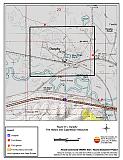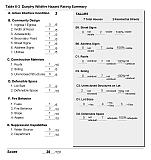8.0 Dunphy
8.1 Risk and Hazard Assessment
Dunphy is a very small community in northern Eureka County located along the Humboldt River and Interstate 80. The Union Pacific Railroad runs through the community. Figure 8-1 shows the community boundary. The community hazard assessment rated Dunphy in the Low Hazard category (36 points). The low hazard rating is primarily attributed to sparse fuels, flat terrain, fire suppression capability, adequate defensible space, and fire resistant building materials. A summary of the conditions that contributed to the hazard rating for Dunphy is included in Table 8-3 at the end of this section.
8.1.1 Community Design
The wildland-urban interface area around Dunphy is characterized as intermix condition. Structures are scattered throughout the wildland area with no clear line of demarcation between wildland fuels and residences. Four of the seven residences assessed were on lots of between one and ten acres in size and three were on lots greater than ten acres in size.
- Access: Dunphy is accessed from Interstate 80. The road is at least 24 feet wide. The secondary roads have grades less than five percent and have adequate turnaround space for fire suppression equipment.
- Signage: Street signs were not clearly posted on either of the two residential streets, and residential addresses were not clearly visible on any of the seven homes in Dunphy. Clear and visible street signs and residential addresses are important in locating homes during low visibility conditions that may occur during a wildfire. However, residences in Dunphy are situated in such a manner that there would be little chance of fire suppression personnel being unable to locate a particular structure in need of protection, even under the low visibility conditions that may occur during a wildfire.
- Utilities: All of the utilities are above ground. Power line corridors need proper maintenance and vegetation clearance to minimize wildfire damage to electric utilities and reduce the possibility that sparks will start a fire in adjacent vegetation.
8.1.2 Construction Materials
All of the homes observed in the interface area were built with ignition resistant treated wood siding materials and ignition resistant roofing materials such as composition, metal, or tile. Two of the homes observed had unenclosed balconies, porches, decks or other architectural features that provide areas where sparks and embers can be trapped, smolder, ignite, and rapidly spread fire to the home.
8.1.3 Defensible Space
All of the homes met the minimum recommended defensible space to help protect the home from damage or loss during a wildfire.
8.1.4 Suppression Capabilities
Wildfire Protection Resources
The Dunphy Volunteer Fire Department, as part of the NDF Eureka County Fire Protection District, provides fire protection in Dunphy. The Dunphy Volunteer Fire Department has one station and reported fifteen volunteers at the time that interviews were conducted for this project. Additional resources are available to respond to a wildland fire from the BLM Battle Mountain and Elko Field Offices and the NDF Carlin Conservation Camp as described in Section 4.1.1. Table 8-1 lists the types of wildfire resources, cooperating partners, and equipment available for initial response to a reported wildland fire near Dunphy.
| Type of Equipment | Amount of Equipment | Cooperating Partner (Resource Location) |
|---|---|---|
| Engine Type 6 Engine Type 3 Water Tender |
1 1 1 |
Dunphy Volunteer Fire Department |
| Engine Type 6 Engine Type 3 Water Tender Type 1 |
1 1 1 |
Beowawe Volunteer Fire Department |
| Engine Type 3 Water Tender Type 2 |
1 1 |
Crescent Valley Volunteer Fire Department |
| Type 3 Engine Type 6 Engine Water Tender |
2 1 1 |
Carlin Volunteer Fire Department (Elko County) |
| Source: Dan Gralian, Fire Chief Dunphy VFD. | ||
Water Sources and Infrastructure
There are no designated water sources for fire suppression in Dunphy. Available water includes the Humboldt River, private agricultural wells, and the Barite Mine.
Detection and Communication
Fires in Dunphy are reported by calling 911. Fires are communicated to fire response personnel through fire dispatch in the Eureka County Sheriff’s Office in Eureka.
The Dunphy VFD has access to State mutual aid frequencies and is compatible with neighboring agencies. There are gaps in radio coverage due to the terrain.
Fire Protection Personnel Qualifications
Some of the volunteer firefighters have received wildland firefighting training from the Nevada Division of Forestry. The volunteer fire departments in Eureka County use a modified red card system that certifies that a volunteer is qualified for wildland firefighting within their own fire district.
Work Load
The Dunphy Volunteer Fire Department did not respond to any wildland / brush fire calls in 2003.
Financial Support
Financial support for the Dunphy Volunteer Fire Department comes through the Nevada Division of Forestry Eureka County Fire Protection District, which is funded from the Eureka County general fund.
Community Preparedness
Eureka County has a Local Emergency Planning Committee and has adopted an emergency plan for hazardous materials and an all-risk disaster response plan that includes emergency evacuation.
8.1.5 Factors Affecting Fire Behavior
Fuel density around Dunphy is low to medium and was estimated at two to three tons per acre. The fuel hazard was considered moderate. The fuels are dominated by greasewood and other shrubs including ephedra, big sagebrush, and rabbitbrush on specific soil associations. Riparian areas along the Humboldt River typically have higher fuel densities and include willow in additions to other shrubs. Ground fuels consist of pepperweed, annual mustard, cheatgrass, saltgrass, Great Basin wildrye, and other perennial grasses. The slopes are generally less than eight percent with a very slight north aspect. The predominant winds are from the southwest and west.
8.1.6 Fire Behavior Worst-case Scenario
A worst-case wildfire scenario for Dunphy would occur in mid to late summer after a year of above normal precipitation and high cheatgrass production. High volumes of dry cheatgrass and annual weeds will provide an easily ignited fine fuel bed that can readily carry fire through the brush under windy conditions. Strong erratic winds greater than twenty mph during lightning storms could push fires into the community from any direction. Multiple ignitions caused by dry lightning strikes in the afternoon could exceed the initial attack capabilities of the volunteer fire department. Fires to the south or west of Dunphy pose the greatest threat since predominant winds are from the southwest and west.
8.1.7 Ignition Risk Assessment
The ignition risk in Dunphy is moderate based on previous fire history.
8.2 Risk and Hazard Reduction Recommendations
The risk and hazard reduction recommendations for Dunphy focus on maintaining defensible space. Other recommendations pertain to community coordination, public education, and fire personnel training that could be initiated to enhance fire safety.
8.2.1 Defensible Space Treatments
Defensible space treatments are an essential first line of defense for residential structures. The goal of the treatments is to significantly reduce or remove flammable vegetation within a prescribed distance from structures. (Refer to Appendix E for the recommended defensible space area). Defensible space reduces the fire intensity and improves firefighter and homeowner chances for successfully defending a structure against oncoming wildfire.
Property Owners Recommendations
- Continue to remove, reduce, and replace vegetation around homes according to the guidelines in Appendix E. This area should be kept:
- Lean: There are only small amounts of flammable vegetation.
- Clean: There is no accumulation of dead vegetation or other flammable debris.
- Green: Existing plants are healthy and green during the fire season.
- Maintain defensible space annually.
- Immediately remove cleared vegetation to an approved disposal site when implementing defensible space treatments. This material dries quickly and presents a fire hazard if left on site.
- Clear around propane tanks for a minimum distance of ten feet and maintain this area free of accumulated vegetation and combustible materials.
- Maintain areas under wood decks and porches free of weeds and other flammable debris. Install screens around unenclosed overhangs where possible. Box in eves and cover attic openings with very fine metal wire mesh to prevent embers from entering the attic space.
- Where cheatgrass or other annual grasses have become dominant within the defensible space zone, areas should be mowed prior to seed set or treated with an application of pre-emergent herbicide.[5] Treatments may need to be repeated for several years to ensure that the bank of unwanted annual plant seeds has been depleted. Refer to Appendix E for a recommended seed mixture and planting guidelines that can be used in conjunction with annual grass removal.
8.2.2 Fuel Reduction Treatments
Dunphy Volunteer Fire Department
- Establish and promote a program for cleaning weeds and debris from around structures and fences in the community.
Electric Utility Company
- Mow, remove, or prune all vegetation to maintain a minimum clearance of fifteen feet around all utility poles. Reseed with a fire-resistant seed mixture such as recommended in Appendix E if necessary to control cheatgrass and other noxious weeds.
8.2.3 Fire Suppression Resources
Dunphy Volunteer Fire Department and Nevada Division of Forestry
- Meet annually with the Bureau of Land Management to review pre-attack plans and to coordinate firefighting resources and response procedures including radio coverage and compatibility.
- Assure that volunteer firefighters receive annual wildland fire training including the use of fire shelters and State Fire Marshal structure firefighting training.
8.2.4 Community Coordination and Public Education
Dunphy Volunteer Fire Department
- Distribute copies of the publication “Living with Fire” to all property owners. This publication is free of charge. Copies can be requested from the University of Nevada Cooperative Extension.
8.3 Summary of Recommendations
| Involved Party | Recommended Treatment | Recommendation Description |
|---|---|---|
| Property Owners | Defensible Space | Remove, reduce, and replace vegetation around homes, according to the guidelines in Appendix E. Maintain the defensible space annually. |
| Dunphy Volunteer Fire Department Nevada Division of Forestry |
Fuels Reduction | Establish and promote a program for cleaning weeds and debris from around structures and fences in the community. |
| Fire Suppression Resources | Distribute copies of the publication “Living With Fire” to all residents. This publication is free of charge. Copies can be requested from the University of Nevada Cooperative Extension. Meet annually with the Bureau of Land Management to discuss the pre-attack plans, coordinate resources, and test radio coverage and compatibility. Assure that volunteer firefighters receive annual wildland fire training including the use of fire shelters and State Fire Marshal structure firefighting training. |
|
| Electric Utility Company | Fuel Reduction | Remove, mow, or prune all vegetation to maintain a minimum clearance of fifteen feet around all utility poles. |
Figure 8-1Dunphy Fire History and Suppression Resources |
 |
Table 8-3Dunphy Wildfire Hazard Rating Summary |
 |
